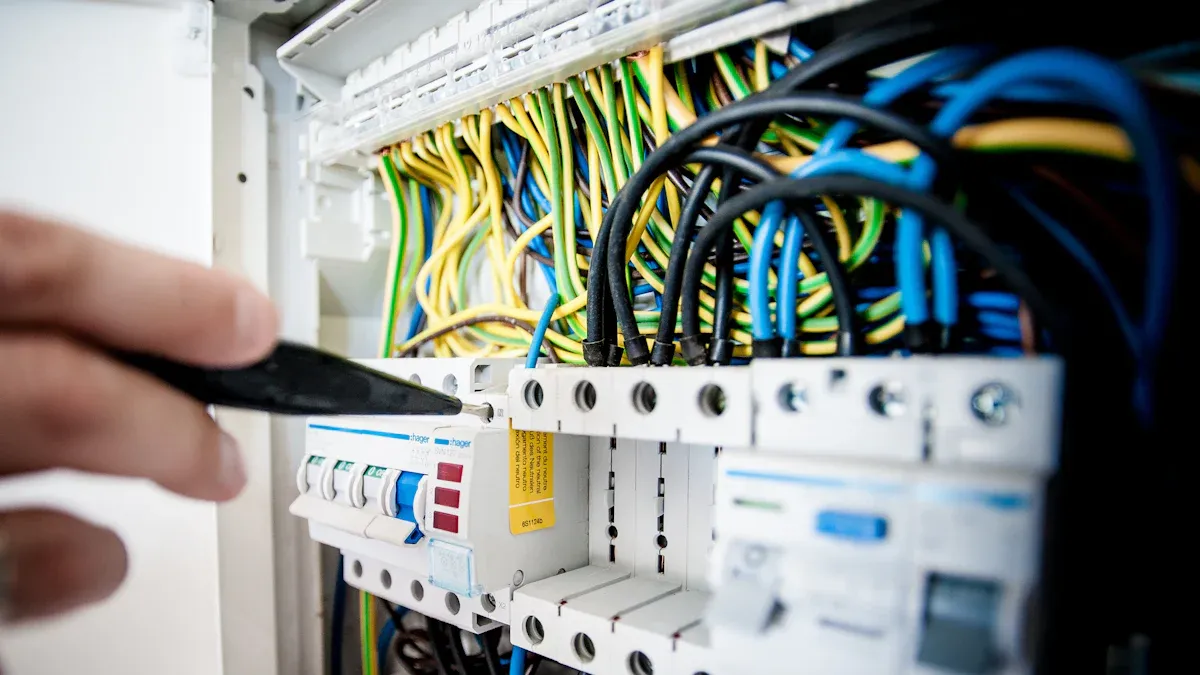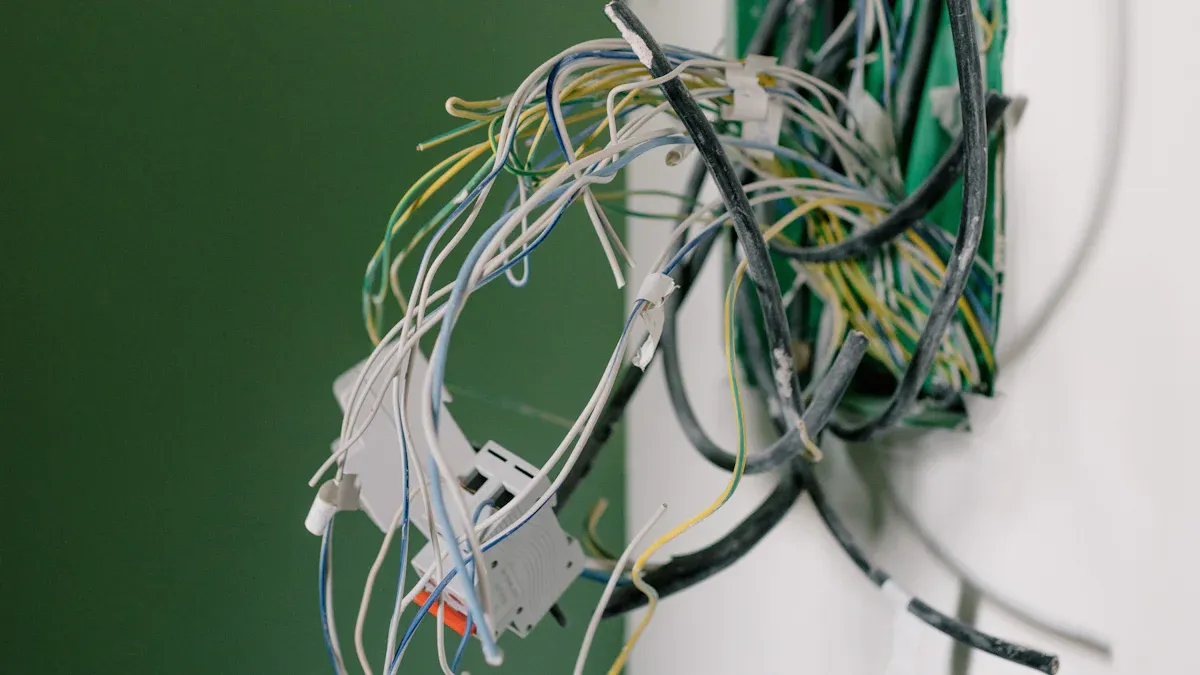
Power cord safety should be part of your daily routine. Neglecting it can lead to electrical hazards and equipment failure. Damaged cords pose risks like shocks or overheating. Proper care ensures safer use, lowers repair costs, and extends the cord’s lifespan. You protect yourself and your devices by following simple safety practices every day.
Key Takeaways
- Check your power cords every day for any damage. Look for cuts, worn-out covers, or burn marks to stay safe.
- Keep cords away from heat and water. Store them in a cool, dry spot to keep them safe.
- Use the correct cord for your devices. Make sure the voltage and wattage match to stop overheating.
Preventive Measures for Power Cord Safety

Avoiding Physical Damage
Protecting your power cord from physical damage is essential for safety and longevity. Cords often face risks like being pinched, crushed, or cut. You can prevent these issues by following a few simple steps:
- Avoid placing cords under heavy furniture or equipment. The weight can crush the insulation and expose the wires.
- Keep cords away from sharp edges. Sharp objects can slice through the outer layer, increasing the risk of electrical hazards.
- Do not pull cords to unplug them. Always grip the plug firmly to disconnect it from the outlet.
Tip: Use cord protectors or covers in high-traffic areas to shield your cables from accidental damage.
By taking these precautions, you reduce the chances of accidents and extend the life of your power cord.
Proper Installation Practices
Installing power cords correctly ensures they function safely and efficiently. Improper installation can lead to overheating or short circuits. Follow these best practices:
- Use the right cord for the job. Check the cord’s voltage and wattage ratings to ensure compatibility with your devices.
- Secure cords properly. Use cable clips or ties to keep them in place and prevent tripping hazards.
- Avoid overextending cords. Stretching them too far can weaken the internal wires and cause damage.
Note: If you need to use an extension cord, choose one with the appropriate rating and avoid connecting multiple cords together.
Proper installation minimizes risks and keeps your electrical setup safe.
Keeping Cords Away from Heat and Moisture
Heat and moisture are two of the biggest threats to power cords. Exposure to these elements can degrade the insulation and lead to dangerous situations. Here’s how you can protect your cords:
- Keep cords away from heat sources. Avoid placing them near heaters, stoves, or direct sunlight.
- Prevent contact with water. Never use cords in wet areas or leave them exposed to rain.
- Store cords in a dry, cool place. Proper storage helps maintain their condition and prevents damage.
Reminder: If a cord gets wet, unplug it immediately and let it dry completely before using it again.
By keeping cords away from heat and moisture, you ensure their safety and durability.
Daily Power Cord Inspection Checklist
Regular inspections are crucial to maintaining the safety and functionality of your power cords. A quick daily check can help you identify potential issues before they become serious problems. Use this checklist to ensure your cords remain in top condition.
Checking for Visible Damage
Start by examining your power cord for any obvious signs of damage. Look for cuts, cracks, or exposed wires along the length of the cord. These issues can lead to electrical hazards or device malfunctions.
- Inspect the plug and connectors. Ensure they are not bent, broken, or discolored.
- Check for frayed or split insulation. Damaged insulation exposes the wires, increasing the risk of shocks or short circuits.
- Look for burn marks or melted areas. These could indicate overheating or previous electrical faults.
Tip: If you notice any visible damage, stop using the cord immediately and replace it to avoid accidents.
Ensuring Proper Insulation
The insulation on your power cord plays a vital role in protecting you from electrical shocks. It also prevents the wires from coming into contact with each other or external objects. During your inspection:
- Feel the cord for soft spots or irregularities. These could indicate weakened insulation.
- Verify the insulation is intact along the entire length. Even small cracks can compromise safety.
- Ensure the cord is not sticky or brittle. These signs often mean the insulation is deteriorating.
Reminder: Never attempt to repair damaged insulation with tape. Always replace the cord to maintain safety.
Monitoring for Wear and Tear
Daily use can cause gradual wear and tear on your power cords. Identifying these signs early can help you prevent more significant issues. Pay attention to:
- Frequent bending or twisting points. These areas are more prone to damage.
- Discoloration or fading. This could indicate exposure to heat or sunlight.
- Loose connections at the plug or device end. These can lead to poor performance or overheating.
Note: Keep a log of your inspections. Tracking wear and tear over time helps you decide when to replace a cord.
By following this checklist, you can ensure your power cords remain safe and functional. Regular inspections not only protect you but also extend the lifespan of your cords.
Maintenance Best Practices for Power Cords
Cleaning and Lubrication
Keeping your power cord clean ensures it functions properly and lasts longer. Dust and grime can accumulate on the cord’s surface, potentially affecting its performance. Use a soft, dry cloth to wipe the cord regularly. For stubborn dirt, dampen the cloth slightly, but avoid using harsh chemicals that could damage the insulation.
Lubrication is not typically required for power cords, but if you use connectors or plugs with moving parts, apply a small amount of electrical-safe lubricant. This prevents rust and ensures smooth operation. Always follow the manufacturer’s guidelines when choosing cleaning materials or lubricants.
Tip: Clean your cords monthly to maintain their condition and prevent buildup of debris.
Replacing Worn or Damaged Cords
A damaged power cord poses serious risks, including electrical shocks and fires. Replace cords immediately if you notice frayed insulation, exposed wires, or loose connections. Never attempt to repair a cord with tape or glue, as this compromises safety.
When replacing a cord, choose one that matches the original specifications. Check the voltage and wattage ratings to ensure compatibility with your devices. If you’re unsure, consult a professional to avoid mistakes.
Reminder: Dispose of damaged cords responsibly to prevent environmental harm.
Record-Keeping for Inspections and Repairs
Tracking inspections and repairs helps you stay organized and ensures your cords remain safe. Create a simple log to record the date of each inspection, any issues found, and actions taken. Include details like the cord’s location and its condition during the check.
Use a table format for clarity:
| Date | Cord Location | Condition | Action Taken |
|---|---|---|---|
| 10/01/2023 | Office Desk | Frayed Insulation | Replaced Cord |
| 10/15/2023 | Workshop | Good | No Action Needed |
Note: Regular record-keeping helps you identify patterns and plan replacements before cords fail.
Everyday Power Cord Safety Tips
Avoiding Overloading Circuits
Overloading circuits can lead to overheating, electrical fires, or damage to your devices. To prevent this, always check the power requirements of your equipment before plugging them in. Avoid connecting too many devices to a single outlet or power strip. Each circuit has a maximum capacity, so exceeding it creates a safety hazard.
Use surge protectors to safeguard your devices from power surges. These devices help distribute electricity evenly and reduce the risk of overloading. If you notice flickering lights or frequently tripped breakers, it may indicate an overloaded circuit. Address these issues immediately to maintain a safe environment.
Tip: Label your circuits and outlets to track which devices are connected. This makes it easier to manage your electrical load.
Keeping Cords Organized and Untangled
Tangled cords not only look messy but also pose tripping hazards and increase wear and tear. Keep your power cords organized by using cable ties, clips, or cord organizers. Group cords together and secure them to prevent tangling. Avoid letting cords dangle or stretch across walkways.
Store unused cords properly by coiling them neatly and placing them in a designated storage area. This prevents damage and makes it easier to find the right cord when needed. Organized cords improve safety and extend their lifespan.
Reminder: Regularly inspect your storage area to ensure cords remain untangled and in good condition.
Training Staff on Safe Handling Practices
If you work in a shared space, training staff on proper power cord handling is essential. Teach them how to identify damaged cords, avoid overloading circuits, and store cords correctly. Provide clear instructions on unplugging devices safely and using the right cord for each task.
Conduct regular safety workshops or briefings to reinforce these practices. Encourage staff to report any issues they notice, such as frayed cords or loose connections. A well-trained team helps maintain a safe and efficient workspace.
Note: Create a simple guide or checklist for staff to reference. This ensures everyone follows the same safety standards.
Power cord safety starts with simple daily habits. Inspect cords, avoid overloading circuits, and store them properly. These steps protect you and your devices while saving money.
Reminder: Consistent care prevents hazards and extends cord lifespan. Start practicing these tips today to create a safer and more efficient environment.
FAQ
How often should you inspect power cords?
Inspect power cords daily to catch visible damage or wear early. Regular checks prevent hazards and ensure cords remain safe and functional.
Can you repair damaged insulation with tape?
No, tape compromises safety. Replace cords with damaged insulation immediately to avoid electrical hazards and ensure proper functionality.
What’s the best way to store unused cords?
Coil cords neatly and store them in a dry, cool area. Use organizers to prevent tangling and protect cords from damage.
Post time: Apr-28-2025
